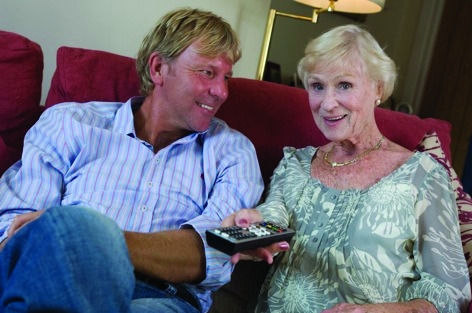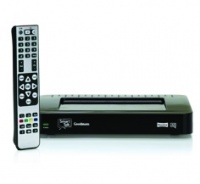
By 2012 the UK’s TV aerials will no longer receive analogue signals from television transmitters.
Region by region, analogue channels will have been switched off and replaced with Freeview, the free-to-air digital TV and radio services that will give consumers considerably more viewing choice than currently available.
The leap from five terrestrial TV channels to as many as 40 or more with Freeview, plus access to 20 digital radio channels and interactive services marks a boom for consumers. Further consumer benefits will be felt as the move to digital frees up the airwaves for new services which include mobile TV and ultra-fast wireless broadband.
This radical overhaul of Britain’s broadcasting services come at a modest financial cost to the consumer who will need to make sure they have the right equipment to enjoy the plethora of new content available to them.
According to Digital UK, the company set up by public broadcasters at the request of the government to lead the digital roll-out, a standard digital box retails for around £25. Freeview+ Digital TV recorders start from around £80, whilst integrated digital TVs (iDTV) that have Freeview built-in are available from around £100.
The relatively low cost of the new technology is made even more appealing by the ease of set up. The consumer only needs to follow a few on-screen instructions - once the aerial and SCART lead are connected - in order to start using the new services. Once set up all the functions of the Freeview box – such as parental controls, programme reminders or favourites – are accessed via remote control and notifications or instructions are displayed in text on the TV screen.
This works for most people but presents considerable difficulty for some who are elderly, severely dyslexic or one of the approximately two million people in Britain with sight loss.
RNIB anticipated this and in 2008 commissioned a project to look at the accessibility issues surrounding the digital switchover.
A survey of blind and partially sighted people identified that TV is important, even to those who cannot see the screen; that most cannot independently see text on the television screen; and that most cannot use on-screen information, electronic programme guides or on-screen menus. For these reasons an audible solution was identified to make digital TV inclusive.
Simultaneously, RNIB undertook proof of concept work to identify the requirements for a simple user interface that included text to speech (TTS). The result of the proof of concept work was a user interface specification and a custom designed remote control that could be used to create a Freeview product in Britain.
From the outset RNIB did not want the Freeview box to be complicated, niche or expensive.

Aspects of cost were recognized by project partner Pixsan, a Bradford-based broadcast DVB (digital video broadcasting) software provider who saw that adding complicated speech engines and functionality could easily lead to the finished product being overly expensive.
Similarly, the remote control was also identified as key in the design; its tactility and ergonomics in relation to usability were seen as absolutely essential.
The charity was introduced to Harvard International, a consumer electronics company whose digital TV set-top boxes (STBs), recorders (DTRs) and digital radio are sold under the Goodmans and Grundig brands.
‘They [RNIB] wanted discussions with a company in the volume market with connections to the volume nationwide retailers and that’s how we came to get together with them,’ said John Edwards, director of communications at Harvard International.
Harvard’s enthusiasm was pivotal in bringing Pixsan into the project, which also included TTS software provider Loquendo and TW Electronics who developed the remote control.
The result of their collaboration is SmartTalk, the world’s first Freeview box with integrated TTS which offers 50 Freeview channels and 24 radio channels.
In simple terms, the SmartTalk box instantaneously vocalizes the commands it receives from the remote control so that the user is aware of the text – and therefore options - that are available on the TV screen. It also allows partially sighted users to adjust font sizes and access high-contrast colour schemes in order to follow text more easily.
The £99 product is powered by digital TV software from Pixsan whose DTG (Digital Television Group) compliant middleware and MHEG engine utilise the user interface to ensure the TTS and Graphical User Interface operate efficiently.
According to Jon Williams, MD of Pixsans, the STB industry exists because it is possible to optimise the processing power, memory architecture and other key elements of the hardware design so that costs are optimised.
In the context of the talking set top box project, this presented an interesting challenge to Pixsans.
‘We wanted to minimise the modification,’ said Williams.’ We didn’t want to have additional memory because it adds more cost. The fundamental goal we have in our world is that we absolutely optimise available memory in the product in question.’
Pixsans were able to call upon an MPEG2 device from IBM that offered 350MIPS.
‘This was quite a bit of overhead that would allow us to be able to handle additional basic power required by the TTS engine,’ said Williams.
‘We had to add additional flash,’ he added. ‘Normally, a set-top-box of this type would use about 16MB of Flash. We had to double the flash to accommodate the way the speech engine handles the files it has to process and we also had to double the RAM.’
With the RAM and the format (MPEG-2) for the digital television signals in place, Pixsans found themselves in a myriad of processes.
Part of the job required a re-write of a portion of the OS with Loquendo in order to port the Italian company’s TTS engine, which converts text into its phonetic form. Those phonemes (sentences and phrases) are then extracted into Flash memory.
They then found themselves optimising the amount of memory and the speed of the memory busses to make sure a sensible, readable sound was provided.
‘Another challenge came when converting a particular chunk of text,’ said Williams. ‘The size of the sentence means that it makes a bigger file and the speed at which you process it - and store it in memory, then retrieve it from memory and play it back - is definitely an issue.’
One aspect that the collaborators can not control is the editorial output from a digital TV’s EPG (electronic program guide), especially a soap opera synopsis.
‘The poor TTS engine is there trying to process very, very long sentences which describe soaps, which is much less concise than a description of news programmes,’ said Williams.
‘RNIB’s Jim Astill picked an Emmerdale synopsis as our test sample. At the time we set the criteria up for passing we actually tuned into a channel and went to a soap opera and said “Crikey, look at the size of that one” and Jim said, ‘’Ok, that’s the one we’ll use”. That actually took us a lot of time to get right.’
The user interface was modelled with user groups within RNIB’s demographic to ensure that the speech from the box worked seamlessly with the remote control.
Edwards added that the remote control was designed and mandated by the RNIB.
‘They are entirely happy with it and they say in the research they’ve done it plays to their satisfaction,’ said Edwards.
The finished product is now on the market and its developers hope that it will appeal to consumers beyond the target demographic of the visually impaired.
According to Harvard International, research has identified mass market appeal for SmartTalk with 56 per cent 18-70-year-olds surveyed showing an interest in a talking digital box and that 52 per cent would purchase one for the talking TV guide or because it’s easy to use.
‘In the due process of time boxes and TVs will have this built into them and it will be a normal feature,’ said Edwards. ‘SmartView sets the standard from which we can build on and go forward.’
In the interim the collaborators are looking to sell into countries outside Britain, with Australia earmarked as embarks on its own digital roll out.
Category Sponsor
![]()
Inclusive Design: designing products for users of all abilities
BT, University of Cambridge, Royal College of Art
Inclusive design is an approach to product design that forgoes definitions of consumers categorized as being able-bodied or disabled.Consequently, BT product commissioners and design project managers use the web-based Inclusive Design Toolkit to ensure that all of BT’s new products and services can be used by consumers of all abilities.
Visualise : providing multimedia content to local spectators
University of Bristol, ProVision Communications, Maniac Films, BT, 3CRL, U4EA, International Sportsworld Communicators
Partners working on the VISUALISE project are developing technology that uses wireless technology to provide in-ground spectators at events such as music festivals or race meetings with information, analysis, replays and video feeds currently only available to TV viewers. Achievements to date include a delivery method for multicast live video.




Project to investigate hybrid approach to titanium manufacturing
What is this a hybrid of? Superplastic forming tends to be performed slowly as otherwise the behaviour is the hot creep that typifies hot...